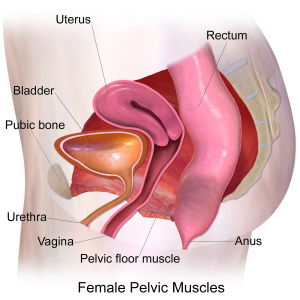What are pelvic floor exercises?
Pelvic floor exercises, sometimes known as Kegel exercises, are something that women should be doing whether they are pregnant or not. Your pelvic floor muscles are the muscles that surround and support the organs in your pelvis- your bladder, uterus and bowels- and are crucial in the control of their function. During pregnancy these muscles are put under a lot of strain with the growing uterus and the birth, therefore it is a good idea to make these as strong as possible! This strength will also help with going to the toilet after you have had your baby.

How are they done?
The first step to overcome is to find your pelvic floor muscles! To locate them, you basically have to imagine that you are trying to hold on to your wee, squeezing a tampon and trying to stop a fart!
Once you have located them you need to be squeezing them every day, with a combination of slow and quick squeezes.
Sit comfortably and do the following:
When you do your slow squeezes, you should slowly tighten your pelvic floor muscles, imagining you are pulling them upwards, and hold this for as long as you can, ideally counting to 10 and then fully relax and start again.
Your quick squeezes are done in the same actions but by doing quick pulses, with 10 pulses in one set. Try and do as many sets as you can.
Women should try to do these slow and quick sets of pelvic floor exercises at least three times a day.
Be careful not to hold your breath, or tighten your stomach, buttock or thigh muscles at the same time.
What does the evidence say?
A recent review from 2017 looked at the data from 38 clinical trials about the use of pelvic floor exercises to prevent incontinence during pregnancy or after birth. This review found that performing pelvic floor exercises from early in pregnancy will help prevent urine incontinence in late pregnancy and after the birth.
This review also noted that this effect could be further increased if specific groups of people who are already at risk of urinary incontinence (such as high BMI) were offered a structured pelvic floor exercise programme.
Useful links and apps
Squeezy – the NHS Physiotherapy App for Pelvic Floor Muscle Exercises
myPFF- pelvic floor exercise app from TENA
Star for Life NHS newsletter: https://www.nhs.uk/start4life/signups/new
Further Reading
Woodley, SJ., Boyle, R., Cody, JD., Morkved, S. and Hay-Smith, EJC. (2017) ‘Pelvic floor muscle training for prevention and treatment of urinary and faecal incontinence in antenatal and postnatal women’ (Review), Cochrane, (12). doi: 10.1002/14651858.CD007471.pub3.www.cochranelibrary.com.
https://www.nhs.uk/common-health-questions/womens-health/what-are-pelvic-floor-exercises/
https://www.tommys.org/pregnancy-information/im-pregnant/exercise-pregnancy/pelvic-floor-exercises




